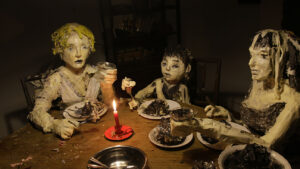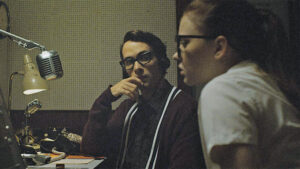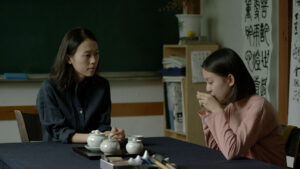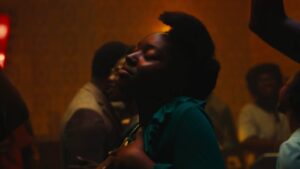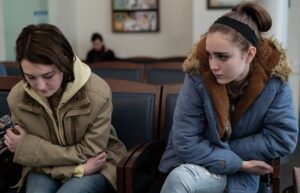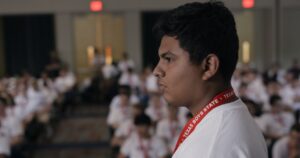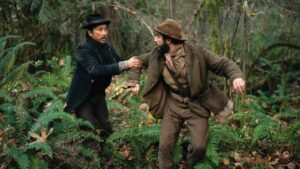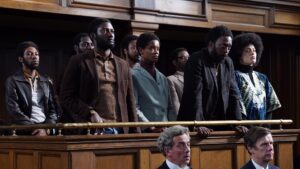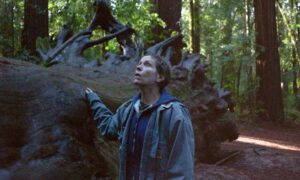Here it is, folks… my favorite films of 2020. Overall, I watched 154 movies, enough to give me a good sampling of the year in cinema. With conditions the way they were, I’ve counted films that had an original theatrical or streaming release in the United States in 2020. (And given the state of film distribution right now, I’ll probably be counting both theatrical and streaming releases going forward.)
Because of that, you won’t be seeing certain films that had an original release in 2021 but were still eligible for the 2020 Oscars. I’m thinking especially of films like The Father, Judas and the Black Messiah,and Minari. These will all be in contention for my 2021 Top 10.
With those parameters set, we shall begin with…
Honorable Mentions (in Alphabetical Order):
The Assistant
Bull
Collective (Colectiv)
Corpus Christi (Boze Cialo)
The Half of It
The Last Tree
Marona’s Fantastic Tale (L’extraordinaire voyage de Marona)
The Personal History of David Copperfield
A Sun (Yangguang puzhao)
Time
10. Dick Johnson Is Dead
Followers of my Top 10s will remember my love of Kirsten Johnson’s previous documentary Cameraperson, and her new film sees her playing with documentary form while telling a deeply personal story. Ostensibly, the doc offers a behind-the-scenes look at a film starring Kirsten’s dad, where he “dies” multiple times before being resurrected in Heaven. Even if you’re not a fan of docs like I am, Dick is so lovable you can be carried along on his smile alone. That’s essential to our experience, as we realize Kirsten is using the film as a way to reckon with her dad’s decline into dementia and eventual passing. With an experimental editing style that flits between “real life” and the movie she claims to be making, the doc questions the very ethics of the filmmaking process, puncturing the illusion that our loved ones will live forever. She does not aim to depress, but instead remind us of the time we’re given (before and after they’re gone).
9. The Wolf House (La Casa Lobo)
If you needed further proof that animated films aren’t necessarily for kids, look no further than Joaquín Cociña and Cristóbal León’s nightmare vision (and my vote for animated film of the year). Inspired by the horrific real-life Nazi colony in rural Chile, the film takes the form of an in-world propaganda film: an unnerving fairy-tale in which a young girl named Maria flees from a “wolf” and takes refuge in an empty house. Using stop-motion, Cociña and León forego any one artistic medium and use them all: paintings, chalk drawings, claymation, papier-mâché, etc. Alternating between 2-D and 3-D (with figures constantly making, re-making, and disintegrating themselves), the film takes the form of a fluid state of mind, with Maria echoing the dogma of the colony even as she tries to distance herself from it. The imagery, while grotesque, may disturb, but it’s the implications of cult mentality behind them that are the true nightmare fuel.
8. The Vast of Night
Andrew Patterson’s sci-fi stunner hits all of my paranormal sweet spots—The Twilight Zone, UFOs, small town horror—so there’s no way it wasn’t going to end up on this list. Boasting crackerjack dialogue and eerie, noir-inspired cinematography, the film explores a possible brush with an alien encounter by two small-town adolescents. As the investigation probes deeper and deeper, the details only grow more and more terrifying, with tales of abductions, coverups, and all kinds of governmental malfeasance. Throughout, the ambition and execution remain high: in one scene, an off-screen witness testifies to his experiences as the screen goes black, letting his words alone paint the frame. Unspooling just enough information without losing its sense of awe or creeping terror, the film thrusts our protagonists headlong into a world they can scarcely understand or even believe. But confront it they must, as must everyone who dares to fly from their small-town perches.
7. House of Hummingbird (Beolsae)
Quiet, heartbreaking, and deeply relatable, Kim Bora’s loosely structured coming-of-age movie avoids neat platitudes about growing up in favor of vividly detailed snatches of life. Set in 1994, the film follows the exploits of Eun-hee, a 14-year-old girl from Seoul, South Korea, confronting the travails of family, academics, and adolescence. Kim has amazing patience as a director, often lingering on abandoned rooms or closed doors after characters have left the frame, letting emotions aerate. But impressive also is Kim’s portrayal of family dysfunction and adolescent conflict, preserving the humanity of her characters while reckoning with the consequences of their actions. There are peaks and valleys to all the events in Eun-hee’s experience, whether it be the stability of her home life or the ups and downs of first romance. Through it all, Eun-hee remains at the center, making her own destiny, creating the language of her life right before our eyes.
6. Small Axe: Lovers Rock
The second entry in Steve McQueen’s Small Axe film anthology, Lovers Rock cascades over you. Effectively one huge house-party in 1980 West London, the film creates a visual soundscape, celebrating music, intimacy, and joy. It’s steeped in the reggae sounds of the time (to say nothing of the racial furor affecting the city), and McQueen conveys so much through human interaction and musical nuance. He’ll even linger on individual dancers, as if to prove how each one is worthy of our attention. Indeed, the camera always hovers close to the party-goers, hoping not to miss a thing, unveiling an energy and fervor that at one point threatens to blow the house down. For the partygoers, this is church, a holy experience that foreshadows the activism in the area in the intervening decade. Luckily, the film never feels compelled to deliver a political message, expressing it all through a shared experience of vibes and vitality.
5. Never Rarely Sometimes Always
In another director’s hands, a film about two young women trying to acquire an out-of-state abortion may have felt like a slog through interminable misery. But Eliza Hittman puts so much emphasis on her characters, Autumn and Skylar; her film is defined by them before it is defined by any of their many obstacles. Captured in grimy grays and handheld cameras, New York City is rendered chaotic and out of focus (especially identifiable for NYC newbies), while the steely bond between the two women is depicted largely through behavior instead of dialogue. It’s an approach that also serves as guiding principle for Autumn’s many interactions with a callous and often perilous world (especially in the scene that references the movie’s title). While bleak, the film gives stark reality to the dangers that women face as access to birth control becomes increasingly dire. But it’s not a polemic; it’s about the real people that exist behind the headlines.
4. Boys State
Amanda McBaine and Jesse Moss’s documentary is so compelling, it’s easy to forget you’re not actually in the room with these young men as they take their assignments (and themselves) so seriously. Focusing on a program run by the American Legion, McBaine and Moss put us right in the thick of a faux-gubernatorial race which immerses high school boys in the political process. There’s an incredible sense of balance to the storytelling here; it would have been easy to lionize the more progressive-minded of the participants, but even students like Steven Garza and René Otero are allowed the kind of shading that speaks to their sincere beliefs and political tactics. Meanwhile, the more conservative students feel all-too-human in the way they rationalize their own views and methods. The film offers as much a commentary on contemporary politics as it does a harbinger for the future. Add to that bold camerawork and piercing interviews, and you have my favorite documentary of the year.
3. First Cow
Watching First Cow makes me realize how conservative many so-called “revisionist westerns” are in comparison. Unlike those films, Kelly Reichardt’s 1840s Oregon Country-set drama doesn’t feel the need to portray extreme violence in order to subvert it; she focuses on her characters’ kindnesses, domestic lives, and wistful dreams for a better life. These are the kinds of people that populate the background of other westerns, and John Magaro and Orion Lee imbue them with rich inner lives and purposeful personality quirks. There’s such patience and compassion to the camerawork, with skillful pans and unexpected angles that reflect the diverse population in the area (both the haves and the have-nots). And I will maintain that Kelly Reichardt is as good at constructing a suspenseful set-piece as any filmmaker working today, made even more apparent here because of how easily we fall in love with her characters.
2. Small Axe: Mangrove
What an opening salvo for Steve McQueen’s Small Axe anthology. Taking place in late ’60s/early ’70s West London, the film details the real-life trial of nine black activists tried for allegedly inciting a riot. Simmering with passion and righteous anger, the film astounds with massive crowd scenes as meticulous in construction as they are spontaneous in execution. Shaun Parkes and Letitia Wright leave quite the impression, but the entire ensemble deserves acclaim for creating such unique, lived-in human beings. What’s more, McQueen takes all the hallmarks of the courtroom drama—cutting cross-examination, incisive testimony, mic drops—and amplifies them through sheer filmmaking prowess, tweaking the genre without upending it. This would have been the perfect experience with a movie theater audience, even as the final shot makes clear the fight for equality is far from over.
1. Nomadland
Another year, another alignment between me and the Academy (maybe I’m starting to lose my touch?). But Chloe Zhao’s lyrical amble of a film lives up to the hype, and the pure experience of watching it makes any outside commentary fall away. Plot is simple as to be non-existent, with Frances McDormand’s Fern living gig-to-gig, traversing the country in her van. But Zhao immerses us in a richly textured world from first frame to last, with Terence Malick-esque montages that give dignity to itinerant lives. And her filmmaking contains such a rich vein of empathy, presenting characters who teem with regret but ache for connection, however brief. Frances McDormand is excellent, of course, and never reduces Fern to a stubborn stereotype; even her firm decisions are clouded by doubt, reflected in deep lingering stares down roads untraveled. The film so expertly interweaves happiness and melancholy, often in the same scene. Nomadland makes you want to drink this life in deep, no matter how you choose to live it.
And with that, we finally leave 2020 in the past. Expect my 2021 retrospective at some point this century!

